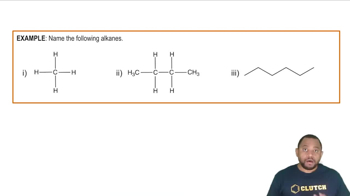Write the chemical formula for each substance mentioned in the following word descriptions (use the front inside cover to find the symbols for the elements you do not know). (b) On treatment with hydrofluoric acid, silicon dioxide forms silicon tetrafluoride and water. (use the front inside cover to find the symbols for the elements you do not know). (c) Sulfur dioxide reacts with water to form sulfurous acid. (use the front inside cover to find the symbols for the elements you do not know). (d) The substance phosphorus trihydride, commonly called phosphine, is a toxic gas. (e) Perchloric acid reacts with cadmium to form cadmium(II) perchlorate.
Ch.2 - Atoms, Molecules, and Ions
Chapter 2, Problem 81b3
(b) Pentane is the alkane with a chain of five carbon atoms. Determine its empirical formula.
 Verified step by step guidance
Verified step by step guidance1
Understand that the empirical formula represents the simplest whole-number ratio of atoms of each element in a compound.
Recall that pentane is an alkane with five carbon atoms, and alkanes follow the general molecular formula where is the number of carbon atoms.
Substitute into the formula to find the molecular formula of pentane: .
Determine the ratio of carbon to hydrogen atoms in the molecular formula, which is 5:12.
Since 5 and 12 have no common factors other than 1, the empirical formula is the same as the molecular formula: .

Verified video answer for a similar problem:
This video solution was recommended by our tutors as helpful for the problem above.
Video duration:
1mWas this helpful?
Key Concepts
Here are the essential concepts you must grasp in order to answer the question correctly.
Alkanes and Their Structure
Alkanes are hydrocarbons consisting only of single bonds between carbon atoms, forming a saturated chain. Pentane specifically has five carbon atoms connected in a straight chain, with hydrogen atoms filling the remaining valences. Understanding the structure helps determine the molecular formula.
Recommended video:
Guided course

Naming Alkanes Example
Molecular Formula vs. Empirical Formula
The molecular formula shows the exact number of each atom in a molecule, while the empirical formula represents the simplest whole-number ratio of atoms. For pentane, the molecular formula is C5H12, and the empirical formula is derived by simplifying this ratio.
Recommended video:
Guided course

Empirical vs Molecular Formula
Determining Empirical Formula
To find the empirical formula, divide the number of atoms of each element in the molecular formula by their greatest common divisor. For pentane (C5H12), since 5 and 12 share no common divisor other than 1, the empirical formula remains C5H12.
Recommended video:
Guided course

Empirical vs Molecular Formula
Related Practice
Textbook Question
Textbook Question
Assume that you encounter the following sentences in your reading. What is the chemical formula for each substance mentioned? (c) Hydrogen cyanide is a very poisonous gas.
Textbook Question
(a) What is a hydrocarbon?
Textbook Question
(b) Pentane is the alkane with a chain of five carbon atoms. Determine its molecular formula.
Textbook Question
(a) What is meant by the term isomer?
Textbook Question
(b) Among the four alkanes, ethane, propane, butane, and pentane, which is capable of existing in isomeric forms?
